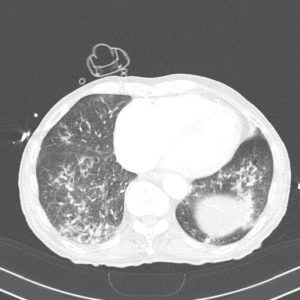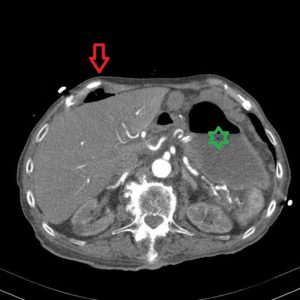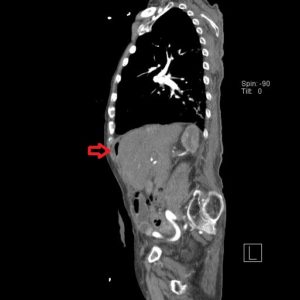
A 99-year-old patient was found unconscious in a sitting position and breathing spontaneously. His son called an ambulance. The physician who arrived intubated the patient and transported him to the emergency. Hypotension 50/20 mmHg. Administration of several boluses of the crystalloid solution and continuous administration of noradrenaline. Bedside echocardiography was performed – a physician at emergency reported no RWMA, no right ventricular overload and no tamponade. Free fluid (with solid content) was found in left hypochondrium. Invasive blood pressure measurement was established. A nasogastric tube was inserted, 2000 ml of intestinal content were evacuated. CT of brain, thorax and abdomen was performed. The patient was transferred to the ICU.
Admission to ICU: continuous administration of noradrenalin 0.6 mg/h, blood pressure (invasive measurement) 100/50 mmHg, almost no blood supply to the periphery, lactate 6 mmol/l, mechanical ventilation, good blood gas exchange, haemoglobin 125 g/l, CRP 200 mg/l, no leucocytosis. Central venous catheter was inserted.
CT findings:
Native CT scan of the brain: bleeding was not detected.
Thoracic CT: neither pneumothorax nor fluidothorax was detected, there were irregular spotty non-merging infiltrations in both lungs.
Abdominal CT: there was free air above liver (pneumoperitoneum), a potential source of air was not detected, dilation of intestinal loops, retention stomach, no free fluid was detected in the abdominal cavity, without suspicion of intestinal ischemia or any other vascular obturation, kidneys did not present with congestion.
Air pocket above liver (red colour) and dilated stomach (green colour).
Recapitulation of CT findings:
- Unconsciousness – no aetiology was revealed by CT. significant hypotension during admission – it could cause impaired consciousness in the 99-year-old patient.
- Pneumoperitoneum and ileus of the small intestine, retention stomach.
- Suspicion of post-aspirational changes of lungs.
Conclusion: acute abdomen with perforation and ileus, septic shock, aspiration pneumonia.
Bedside ultrasonography was performed at ICU to assess the pathophysiology of the shock.
Echocardiography:
<h3>




